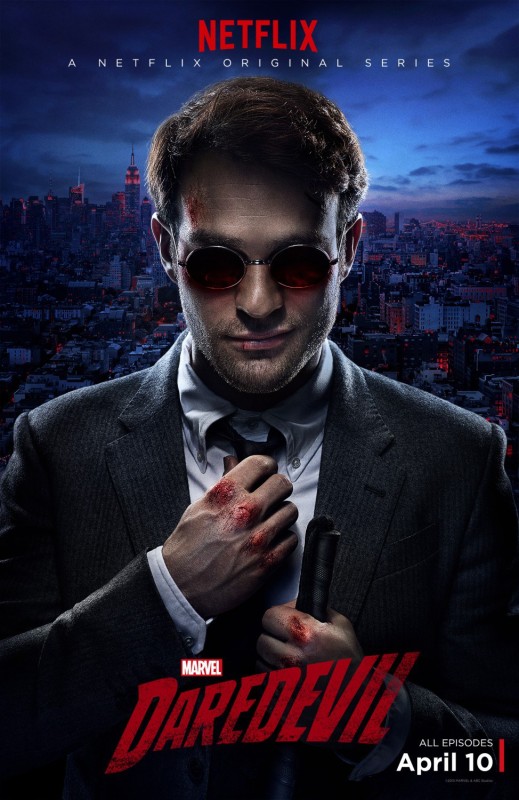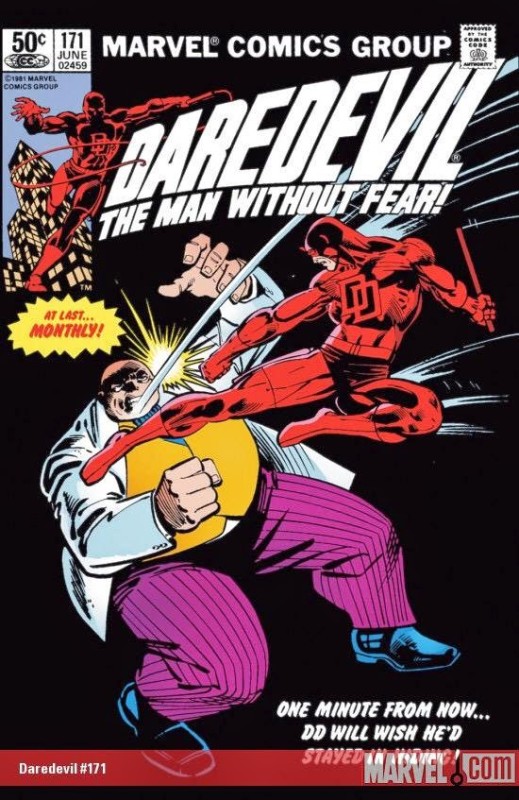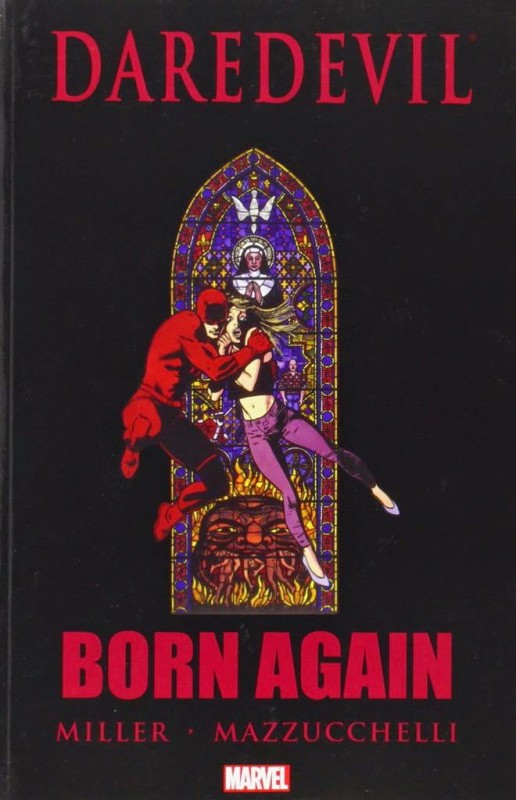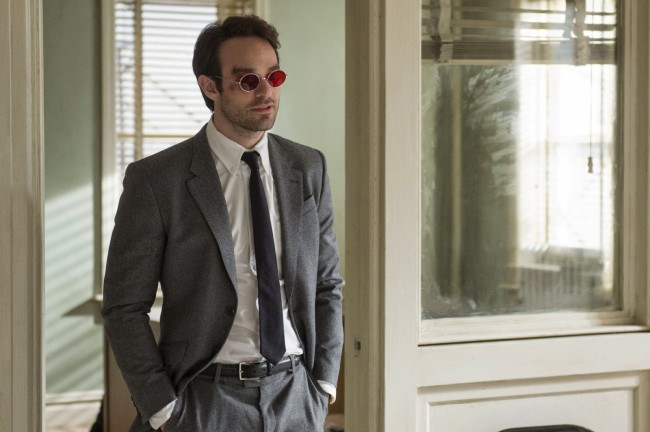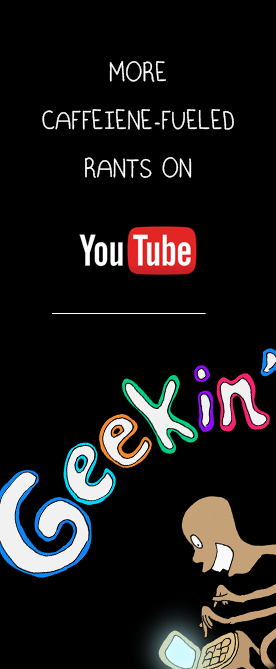When I first heard that Marvel and Netflix were going to partner up for a series of interconnected new shows to take place within the Marvel Cinematic Universe, my immediate reaction was one of cautious optimism. I’ve been reading comics my entire life and I feel the serialized adventures of costumed characters are a perfect fit for the episodic format of television but I have not been overwhelmed by ABC’s family-friendly approach to “Agents of S.H.I.E.L.D” and stopped watching the show early in the 2nd season. I worried that when it came to Daredevil whether or not Netflix would have the courage to allow the show runners to take the character into the dark alleyways of Hell’s Kitchen the way every hardcore fan of the character would want. We’d already been burned once before in 2003 with Fox’s lackluster handling of the character. When I learned that Netflix planned on slowly introducing Luke Cage, Iron Fist, Jessica Jones and other Marvel characters with the long-term goal of creating a street-level vigilante group called “The Defenders”, my curiosity increased even more. I’ve always loved the weaker costumed heroes of the Marvel Universe (Moon Knight, Punisher, etc.) who take care of crime in New York City while leaving the grand scale, cosmic-level threats of alien invasions, etc. to the likes of Thor and Iron Man to handle. But of all the New York-based vigilantes in the Marvel Universe, Matt Murdock aka Daredevil is easily one of the most beloved by fans and most historic for the Marvel brand so there was a lot riding on this show and to what degree fans would embrace it. After spending the last week working my way through the 1st season of “Daredevil”, I’m happy to report that for the most part the show succeeds at delivering an experience that feels very true to the character and its roots, opening the door for more Marvel mayhem on Netflix in the future.
I first encountered the character of Daredevil just shy of my 5th birthday in “Daredevil” #171 (1981). I had no idea at the time that I was diving into the great heyday of Frank Miller and Klaus Janson’s now legendary run on the title, one that is absolutely worth reading in its entirety, but for my impressionable young mind the story was riveting. The story featured a knock down drag out brawl between Daredevil and the Kingpin and ended with a horrifying cliffhanger with Daredevil chained up and submerged in New York’s drainage system left for dead. Not only was I terrified about what was going to happen to this character I had just discovered and fallen in love with, but at that age I had no control over what comics made it into my collection and I never managed to get my hands on the next issue until well into adulthood. So for most of age 5, my only knowledge of Daredevil was this lone story with an ending that was almost too traumatizing to read. I was hooked and now more than 30 years later, I still consistently read stories featuring the character as long as a solid writer and artist are assigned to chronicling his story. So many amazing storytellers have been associated with the character over the years but my favorite storyline has to be the famous “Born Again” arc by Frank Miller and David Mazzucchelli in issues #227-233 (1986). I’d argue that for anyone who has never read a comic in their life, “Born Again” is one of those comics with the power to convert someone into a lifelong reader. It is a tale of the emotional, professional and physical destruction of Matt Murdock at the hands of the Kingpin and Daredevil’s slow painful journey back to reclaiming his position as the protector of Hell’s Kitchen. It is an inspiring story that for me represents the high water mark for the character.
The origins of the character Daredevil go all the way back to 1964 with “Daredevil” #1 written by Stan “The Man” Lee and illustrated by Bill Everett (cover by Jack “The King” Kirby). Matt Murdock’s transformation into Daredevil is one of the best origin stories in comics and a large part of the appeal of the new show is how faithfully it adheres to the roots of the character. The show’s creator, Drew Goddard, has done an amazing job of isolating all the little details that people love about Daredevil’s background and slowly teasing out the details over the course of the season as opposed to forcing us to endure an origin episode, a convention that most people have grown weary of after a decade and a half of being inundated with superhero movies and television shows. For those of you who don’t know, Matt Murdock is blinded as a young child when he pushes someone out of the way of a truck and accidentally gets exposed to chemicals on the vehicle. While robbed of his sight, Murdock’s other senses are enhanced to such a degree that he develops in essence a radar sense that allows him a complete understanding of his environment that normal people will never understand. Murdock’s father, Battlin’ Jack Murdock, is a professional boxer, famous for having never been knocked out in spite of enduring horrific punishment over the course of his fading career. He’s raising Matt on his own and the idea that Murdocks always get up is a lesson Matt takes to heart as a child. Sadly Matt’s father is killed by the mob for refusing to take a dive in a fight leaving Matt to grow up in an orphanage with some crucial tutoring from the blind warrior Stick. Jack always made his son promise that he would learn to use his mind instead of his fists, a promise that continues to fill Matt with guilt (Catholic guilt is a prominent theme in the comics and the show). Matt tries his best to honor his father’s memory and grows up to become a lawyer but quickly realizes that there are some brutal realities about life in Hell’s Kitchen where the law comes up short forcing Matt into a double life as a vigilante by night and lawyer by day as he seeks to make his city a better place. Throughout the show Daredevil seems to use the punishment he receives in battle almost as a form of penance for his sense of guilt and conflicting emotions, leading to some extraordinary fight sequences. Charlie Cox is particularly good at embracing this side of the character.
What is most interesting about this show is the inevitable conflict between Matt Murdock and another man who also has his own vision about how to make New York a better place, Wilson Fisk aka the Kingpin of Crime. As portrayed by Vincent D’Onofrio, Fisk is a conflicted man, haunted by personal demons whose inner rage is always threatening to overwhelm his icy cool that has allowed him to become one of the most successful businessman in New York without becoming a public figure. He’s the comic book equivalent of Tony Soprano and that grounded gritty approach is what sets this show apart from the rest of the Marvel Universe. From the newspaper headlines and reconstruction efforts featured in the backdrop this show does not avoid being associated with the primary-colored superheroics found in movies like “The Avengers” (2012), but still manages to set off in its own unique stylistic direction, one clearly geared toward a more adult sensibility. This is a show where Matt Murdock will calmly say, “I had a really shitty night”, not a line one would expect to see in the comics but feels totally natural in the show’s depiction of life in New York. I live in New York and never grow tired of exploring this fascinating city, a feeling that is perfectly reflected by the show’s depiction of Manhattan’s dive bars, rooftops and dirty alleys where Daredevil does his thing.
https://www.youtube.com/watch?v=vyKdg4blKno
The most entertaining part of Season 1 is watching Daredevil evolve into his role as a superhero as opposed to leaping into his role as the Devil of Hell’s Kitchen fully formed, which a less interesting show would have done. His costume, his gear and his technique all improve with practice. As one can see in the amazing fight scene linked above from Episode 2, Daredevil largely relies on his fists and is fairly vulnerable for a costumed vigilante. But as the story progresses, Daredevil picks up the tricks of his trade such as his famous Billy Clubs. I clapped the first time I saw him slide his weapons into the sheath on his thigh that every fan of the comics will recognize. After nearly being cut to pieces, Daredevil recruits the services of Melvin Potter (who comic fans will recognize as the villain Gladiator) to construct his classic crimson costume and by the end of Season 1, we’ve watched Matt Murdock finally evolve into the hero we’ve known and loved from his adventures in Marvel Comics over the last 50 years. Fans of the character will find an endless supply of Easter Eggs that will delight their fanboy sensibilities from references to Matt’s Greek girlfriend in college (Elektra) to the evil corporation Roxxon who Murdock can’t bring himself to accept as a client while working for a large law firm forcing him and his partner Foggy Nelson to create their own shop. All the essential characters from Daredevil’s universe are present including Karen Page played by the lovely Deborah Ann Woll and Ben Urich played by Vondie Curtis-Hall.
The question that remains is does the show succeed on its own terms or is it simply a well made bit of fan service to keep geeks like me happy in between Marvel movies. This is impossible for me to answer objectively but I would like to think that every detail that makes Daredevil a compelling character on the page has been distilled into this new format. I haven’t binge watched a show in a long time and I found myself seeing the sun rise one night after having watched about 6 episodes in a row. Is the show perfect? Absolutely not. Some subplots bored me to tears and I honestly felt that the show lost some momentum in the final few episodes. Also I’m probably not alone in thinking that Daredevil’s final costume isn’t nearly as cool as his all black homemade wardrobe. All nitpicking aside, however, Netflix has won me over with this show. I can look forward with confidence to the rest of the Marvel projects on their slate knowing that at least someone behind the scenes knows what the hell they are doing. Next up is Luke Cage aka Power Man. I can only hope that somebody on the show has read the masterful “Cage” by Brian Azzarello and Richard Corben. If so, we’re in for a treat.
I am one of the Co-Hosts of the podcast Wrong Reel and you can find our material here:

